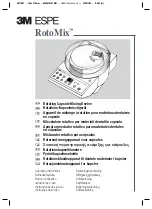
21
SECTION 2 - OPERATION
SAFETY FIRST!
Before loading and operating the machine, ensure that all operator’s
have read and thoroughly understood the safety procedures as stated on pages 6 and 7 of
this manual.
LOADING THE MACHINE
SAFETY FIRST!
All ingredients MUST be loaded mechanically. NEVER attempt to load
the machine by hand except via the mesh covered rear aperture.
IMPORTANT!
Prior to loading into the mixing chamber remove all plastic wrap / net and
string from round or rectangular bales.
1. Ensure that the machine is properly installed and hitched to the tractor as described in Section 1. Check
that the drain plugs on the underside of the machine are securely fitted and that the parking brake is
applied or wheels securely chocked (if applicable).
2.
Optional serrated shear bars can be fitted into the mixing chamber to assist the breakdown of long material
within the mixture.
3.
Position the electronic display unit (where fitted) to face either the tractor cab or to the side of the machine,
as required. If fitted, refer to the weighing system manual supplied with the machine, switch on and zero
the system as instructed.
4.
Start the tractor engine.
5.
Check that the discharge doors are closed and conveyor mechanism (if fitted) is stationary.
6. Operate the weighing system as instructed in the accompanying operator's manual. The weight will be
displayed on the screen.
7.
Engage PTO to start the mixing augers and run at approx. 540 r.p.m.
NOTE!
Unless full length roughage (silage / hay) is to be incorporated into the mix, the augers do not
need to be running at this stage.
8.
Loading sequence for ingredients:
1 -
Round baled material ( load with machine running and from this point onwards )
2 -
Other baled materials
3 -
Rolled cereals
4 -
Minerals & concentrates
5 -
Liquids ( i.e.. molasses )
6 -
Grass silage
7 -
Sugar beet pulp/brewers grains
8 -
Maize silage















































